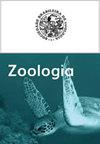Contribution to the knowledge of Brazilian troglobitic Pseudoscorpiones (Arachnida): description of Pseudochthonius lubueno sp. nov. (Chthoniidae) from Serra do Ramalho karst area, state of Bahia, Brazil
IF 1.8
4区 生物学
Q4 ZOOLOGY
引用次数: 0
Abstract
Pseudochthonius lubuenosp. nov., a new obligatory cave-dwelling pseudoscorpion species is described from Gruna da Altina cave, the fifth species of the genus in the region of Serra do Ramalho karst area, southwestern Bahia, Brazil. This genus occurs in South and Central America, sub-Saharan central Africa, and in the Arabian Peninsula. The new species can be identified by the following combination of characters: eyes or eyespots absent, coxa I with two and coxa II with 4-5 coxal spines, without microdenticles on the fixed pedipalpal finger, rallum with five blades, ratio ist-est/ist-esb = 1.9. With this new description, the genus now includes 15 species from Brazil: P. biseriatus Mahnert, 2001, P. brasiliensis Beier, 1970, P. diamachi Prado & Ferreira, 2023, P. gracilimanus Mahnert, 2001, P. heterodentatus Hoff, 1946, P. homodentatus Chamberlin, 1929, P. koinopoliteia Prado & Ferreira, 2023, P. lubueno sp. nov., P. orthodactylus Muchmore, 1970, P. olegario Schimons ky, 2022, P. pali Prado & Ferreira, 2023, P. ramalho Assis, Schimonsky & Bichuette, 2021, P. ricardoi Mahnert, 2001, P. strinatii Beier, 1969 and P. tuxeni Mahnert, 1979. The new species shows troglomorphic characteristics such as the depigmentation of the carapace and the absence of eyes. In addition, illustrations, diagnoses, an identification key for cave-dwelling species of the genus, and distribution maps for all Brazilian species of Pseudochthonius are provided.对巴西穴居假蝎子(蛛形纲)认识的贡献:巴西巴伊亚州Serra do Ramalho喀斯特地区Pseudochthonius lubueno sp. nov.(拟蝎子科)的描述
Pseudochthonius lubuenosp。2011年11月,在巴西巴伊亚州西南部Serra do Ramalho喀斯特地区的Gruna da Altina洞穴中发现了一种新的强制性穴居假蝎子,这是该属的第五种。这个属出现在南美洲和中美洲,撒哈拉以南非洲中部和阿拉伯半岛。该新种可通过以下性状组合进行鉴定:无眼或眼斑,尾骨1有2根,尾骨2有4-5根,固定趾指无微齿,茎部有5片叶片,ist-est/ist-esb = 1.9。有了这个新的描述,该属现在包括来自巴西的15种:P. biseriatus Mahnert, 2001年,P. brasiliensis Beier, 1970年,P. diamachi Prado & Ferreira, 2023年,P. gracilimanus Mahnert, 2001年,P. heterodentatus Hoff, 1946年,P. homelentatus Chamberlin, 1929年,P. koinopoliteia Prado & Ferreira, 2023年,P. lubueno sp. nov, P. orthodactylus Muchmore, 1970年,P. olegario Schimonsky, 2022年,P. pali Prado & Ferreira, 2023年,P. ramalho Assis, Schimonsky & Bichuette, 2021年,P. ricardoi Mahnert, 2001年,P. strinatii Beier, 1969年和P. tuxeni Mahnert, 1979年。新物种表现出诸如甲壳色素脱色和眼睛缺失等troglomerorphic特征。此外,还提供了该属穴居种的图解、诊断、鉴定关键字以及巴西所有Pseudochthonius种的分布图。
本文章由计算机程序翻译,如有差异,请以英文原文为准。
求助全文
约1分钟内获得全文
求助全文
来源期刊

Zoologia
生物-动物学
自引率
0.00%
发文量
15
期刊介绍:
Zoologia, the scientific journal of the Sociedade Brasileira de Zoologia (SBZ), is an international peer-reviewed, open-access Zoological journal that publishes original research on systematics, evolution, taxonomy, nomenclature, biogeography, morphology, physiology, biology, ecology, symbiosis, conservation, behavior, genetics and allied fields. The journal, formerly known as Revista Brasileira de Zoologia, publishes original articles authored by both members and non-members of the Society. The manuscripts should be written exclusively in English.
 求助内容:
求助内容: 应助结果提醒方式:
应助结果提醒方式:


